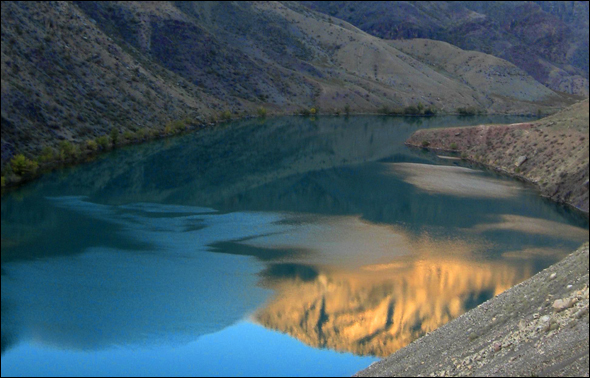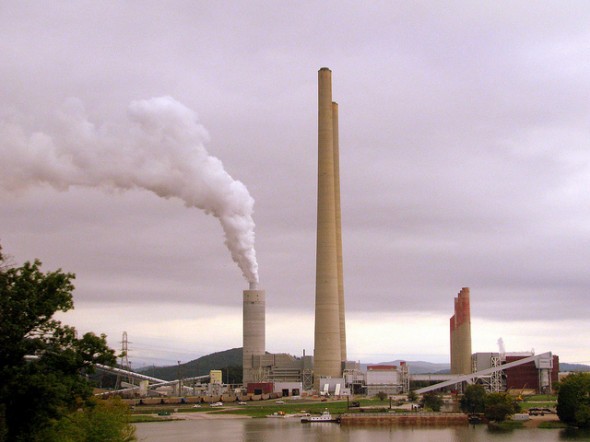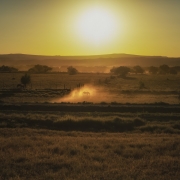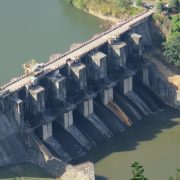U.S. Hydropower Grows By Going Small
Hydropower expansion relies on improving existing dams.
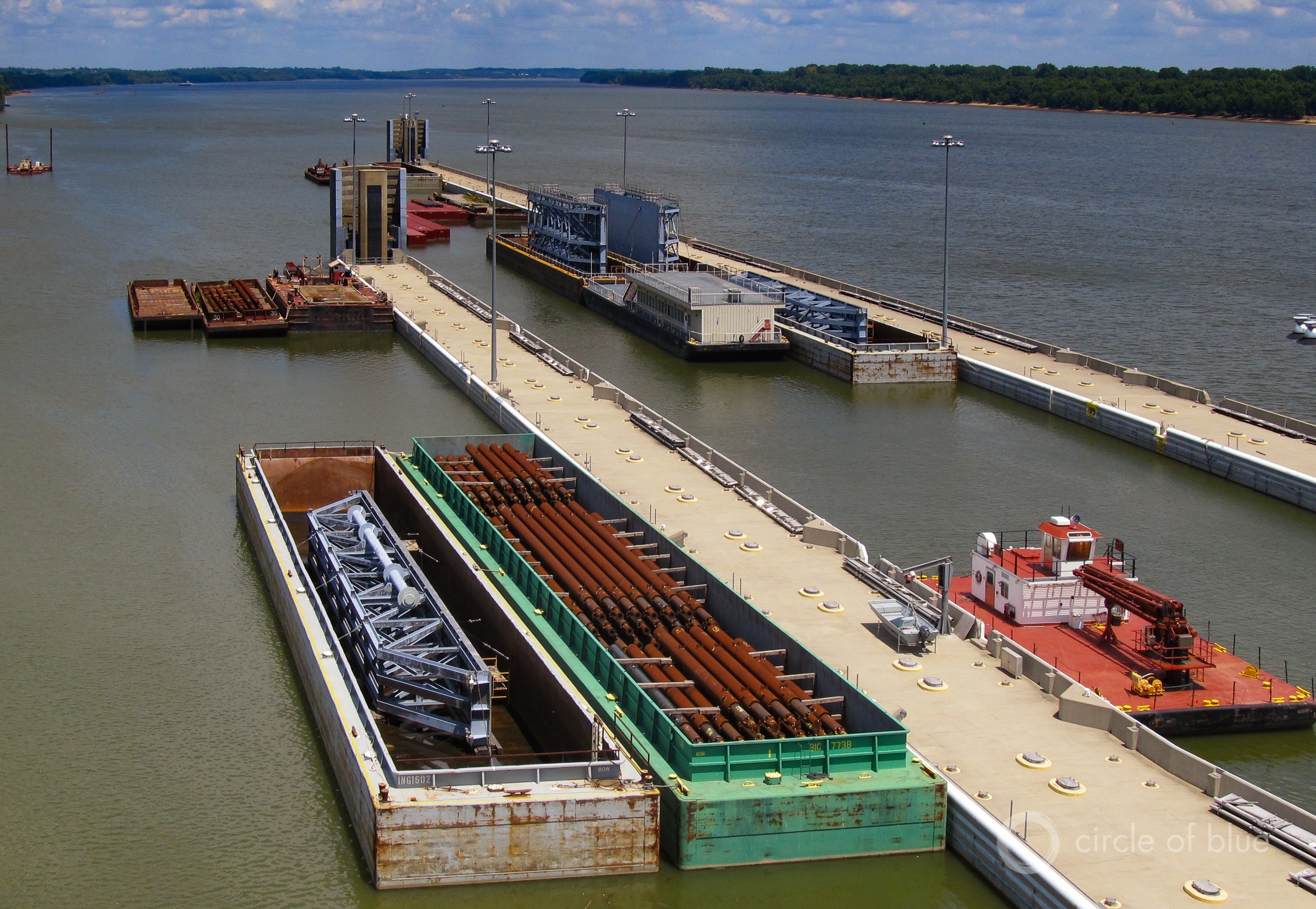
Olmsted Locks and Dam, on the Ohio River between Kentucky and Illinois, has the highest hydropower potential of any dam without the current capacity to generate electricity. The entire watershed is a hot spot for this sort of project. Developers added turbines to three Ohio River locks this year. More than a dozen other electricity-generating projects are planned for locks on the river’s tributaries. Photo © Keith Schneider / Circle of Blue
By Brett Walton, Circle of Blue
Change is coming for the 90-year-old Point Marion Lock and Dam, change that could signal a new direction for America’s water and power infrastructure.
More than a decade ago a steady flow of barges passed through Point Marion, on the Monongahela River in southwest Pennsylvania. Nine locks built between 1906 and 1965 sedated the lower “Mon” into a series of slackwater stair steps that made the river navigable from Pittsburgh toward the West Virginia uplands. The barges delivered mostly coal to power plants and steel mills in the Ohio River Valley but they also carried lumber and construction materials to any number of river towns. For years the system seemed as regular and permanent as the seasons.
And then, it wasn’t. As the U.S. energy market moved away from high-carbon electricity, barge traffic at the lock fell steeply. In the last 25 years, total tonnage dropped by two-thirds.
Point Marion owes its pending makeover to a different form of energy: hydropower. Rye Development, a Boston-based outfit, wants to use the water that flows through the U.S. Army Corps of Engineers facility to move not only cargo but electrons. Rye awaits approval from federal regulators to install five megawatts of hydroelectric capacity at Point Marion, which does not currently generate power. It is one of 23 such projects, all east of the Mississippi River, in which the group is investing some $US 775 million. Its backers view the upgrades, which will add 265 megawatts of capacity, roughly the size of one large dam, as an old idea made new.
“Hydropower has been around for more than a hundred years,” Don Lauzon, a senior vice president at Rye Development, told Circle of Blue. “Water is already running over the dam. Why not capture it, create energy, create power?”
Lauzon’s convictions have high-level support. Both the Obama administration and Congress are bullish on hydropower. Federal authorities view the nation’s largest source of renewable energy as a low-carbon, homegrown energy reserve that is nimble and efficient, able to respond to daily changes in electricity demand and help incorporate a surge of solar and wind power into the grid. “We need sources that bring those attributes to the table and hydropower is definitely one,” Jose Zayas, director of the Department of Energy’s Wind and Water Power Technologies Office, told Circle of Blue.
Hydropower in the United States is primed for a shakeup. On one hand, utilities and governments are tearing down old dams with increasing frequency. These dams often produce little or no power while dividing rivers, decimating fisheries, and sterilizing watersheds. Many of the remaining dams, like much of America’s infrastructure, need significant repairs. Fixing these liabilities would cost $US 57.7 billion, according to a 2012 estimate by the Association of State Dam Safety Officials. Current figures are surely higher.
On the other hand, lawmakers and officials are keen to wring more power from rivers. By unanimous vote, a rare occurrence indeed, Congress changed hydropower licensing procedures in 2013 to coax developers and utilities to boost capacity at existing facilities and to install turbines in dams without them. More recently, the Federal Energy Regulatory Commission (FERC) and the U.S. Army Corps of Engineers, both of which have oversight authority, agreed in July to coordinate permitting for non-federal projects on Corps facilities, like the one Rye is pursuing at Point Marion. The goal is to simplify the approval process, something that a separate 15-agency working group is also addressing. The Energy Department, meanwhile, conducted resource assessments in 2012 and then again this summer to pinpoint existing locks, dams, and pipelines with the most promising power potential and identify obstacles to their development.
Despite favorable political tailwinds, the new era of hydropower is slow to get off the ground. Permitting, which depends on the site and size of the project, can still be a multi-year endurance test. Financing is a challenge. Climate change will influence the amount of water available to generate power. Energy markets are evolving with the rise of solar and wind, and decline of nuclear and coal. All of which means that hydropower is receiving more attention now than at any time in the recent past.
New Path for Hydropower
President Obama, in recent speeches, rarely mentions “all of the above,” the phrase that has come to define his energy strategy. That strategy, first aired in 2012, meant using the full menu of energy options — natural gas, solar, wind, even nuclear, as well as efficiency improvements to vehicle fuel economy, air conditioners, and water heaters — to steadily reduce carbon emissions from electric power and transportation. The president’s silence on the topic in recent speeches is because energy policy is not the front burner issue for the White House that it was a year ago, before the introduction of carbon pollution regulations and the negotiation of an international climate treaty in Paris. Even so, the president’s administration, with help from Congress, continues to tweak federal rules to encourage more power from flowing water.
The map shows hydropower potential at non-powered dams in the United States. Green dots represent projects completed in 2016; red dots, projects under construction; and blue dots, undeveloped locks and dams. Click on a dot for information about the facility. The larger the dot, the larger the generation potential. For a larger version of the map, click here. Map created by Tom McIlwaine / Circle of BlueThe administration’s hydropower push is a distillation of the all-of-the-above strategy. Reviving hydropower does not mean recreating the hulking masses of concrete that defined mid-20th century power development. The prime spots are already plugged, and big new dams no longer fit the time. They are ecologically damaging, take a long time to build, and require a tremendous capital investment. The governor of Alaska, for instance, halted work in June on the $US 5.7 billion, 600-megawatt Susitna-Watana hydropower project because state finances crumbled when oil prices plunged. At 705 feet in height, Susitna-Watana would have been the tallest dam built in the United States since 1973, and it represented more than half of proposed new hydropower capacity in the United States from new dams.
The alternative model is to make better use of infrastructure already in the ground, a less expensive and more efficient use of capital and equipment that is more adaptable to the era. Fewer than three percent of the nation’s roughly 87,000 dams produce power. There are many thousand more canals, pipes, and conduits that carry water to farms and cities and could spin a turbine. The country’s generating capacity — the amount of potential energy from hydropower — has scarcely budged since 1990, the end of the dam-building era. After World War II, hydropower accounted for more than 40 percent of U.S. electricity generation. Its share is now down to six percent. A comprehensive Department of Energy study released in July charted a path for adding some 50 gigawatts of hydroelectric capacity and storage by 2050, an increase of one-third.
That potential increase comes from a variety of sources. Developers could build twinned reservoirs called pumped storage. These facilities — reservoirs with an elevation difference — are a form of battery and are promoted as a means of linking renewables to the grid. The system works by using surplus energy to pump water into an upper reservoir that is then released in the afternoon, when temperatures rise and households turn on air conditioners. Pumped storage is a net loss of energy, but it is the most common way to store power for times of high demand, accounting for 97 percent of large-scale electricity storage in the United States. Most of the 49 projects undergoing permitting are in states with high wind and solar development such as California and Oklahoma, according to the Department of Energy.
Another avenue for improvement is upgrading existing facilities. Since 2005, hydropower plant owners have spent more than $US 6 billion in upgrades or repairs, according to industry research cited by the Department of Energy. The Bureau of Reclamation’s power customers, for instance, paid for new turbines and wicket gates at Hoover Dam. The $US 14.9 million investment allows the iconic dam to produce power even as Lake Mead, its water source, shrinks.
A third option is to add turbines to non-powered dams, the most common project proposal today, or to canals and pipelines (collectively called “conduits”). Both are a way of maximizing the use of existing infrastructure with minimal additional environmental damage and without changing how the current infrastructure is operated. These developments were the target of the Hydropower Regulatory Efficiency Act that Congress unanimously approved in 2013. The act exempted from the FERC licensing process the addition of less than five megawatts of capacity to conduits. Small hydropower projects of less than 10 megawatts were also exempted. The act, however, did not extend exemptions to non-powered dams. Exemptions are not a blank check. Developers must still comply with conditions set by state and federal fish and wildlife agencies.
Even with the policy nudges, progress is slow. As of August 1, in the three years since the act took effect only 65 exemptions have been issued for conduits and none for small hydro, a FERC spokeswoman told Circle of Blue.
Changes in Process
Because the bulk of the nation’s power potential at non-powered dams rests at Army Corps facilities, better coordination between the Corps and FERC could ease the path. Currently each agency requires a separate environmental review under the National Environmental Policy Act. The Corps and FERC signed an agreement in July to align their review processes, which will result in a single NEPA review. Eliminating these redundancies has garnered support from environmental groups that keep close watch on hydropower developments.
“The [agreement] is exactly the direction we should be going for non-powered dams,” Jim Bradley, vice president for policy and government relations at American Rivers, told Circle of Blue.
Rye Development’s proposed installation of five megawatts at Kentucky Lock and Dam No. 11 is the first project in the nation to go through a two-year licensing process, which was authorized in the 2013 congressional bill. Normal licensing can take up to six years.
The Department of Energy, though, argues that more than just licensing changes are needed to boost hydropower. The Hydrovision report, published in July, argued that new financing models and technological improvements that lower costs and protect fisheries are just as important.
Selecting Projects
With tens of thousands of dams and conduits having hydropower potential how to choose what to develop? There are several considerations. Lauzon said that Rye Development prefers to work in “clusters” — groups of neighboring facilities within a watershed. This approach, being used in the Ohio River Basin in western Pennsylvania and on the Muskingum River in Ohio, provides more favorable economics as there is less distance to move construction equipment and supplies, Lauzon said.
Army Corps locks and dam on the Ohio, Mississippi, Arkansas, and Alabama rivers have the greatest potential for new hydropower, according to the Department of Energy. Outside observers say that these facilities, because of their importance for commerce, are suitable spots for turbines.
“There’s a lot of opportunity for hydropower to be added to facilities that have critical authorized purposes,” Bradley told Circle of Blue, referring in particular to the locks and dams that enable barges and ships to navigate rivers. “These are the projects we should be pursuing.”
Projects at other types of dams mimic that approach. Ball Mountain and Townshend, for instance, are two flood control dams on Vermont’s West River, a tributary of the Connecticut River. Eagle Creek Renewable Energy is installing turbines on both dams. David Deen, who represented the Connecticut River Watershed Council, a river advocacy group, in the FERC licensing process, said that because the dams are designed to dampen floods, they are not going to be removed. That being the case, adding hydropower made sense, he said.
Townshend’s license states that there will be no change in dam releases to favor hydropower, which makes it less nimble than at dams where hydropower is a primary purpose. The license also includes environmental protections such as a downstream detour around the deadly turbine blades for Atlantic salmon. Though an upstream passage was not required, Deen said that he is satisfied with the outcome. “As power projects go, it’s had very little additional negative impact on the river,” Deen told Circle of Blue.
What projects then should not be considered? According to Bradley, those that extend the life of an unnecessary dam.
“We don’t want to see small amounts of power development at dams that are old, have outsized environmental impacts, and ought to be removed,” he said. These attributes must be evaluated case by case.
The environmental consequences of the new hydropower model are not so easily catalogued either, according to multiple engineers and ecologists interviewed by Circle of Blue. Adding a turbine to an existing lock is certainly less destructive than walling off a fresh stream. But a full accounting requires knowledge of changes in reservoir releases and the fish species in the river, according to Desiree Tullos, a water resources engineer at Oregon State University. Different fish species will respond differently to the pressures exerted by turbine outlets.
“I realize that isn’t a satisfying answer, but it like most things in ecosystems, I have to say that, ‘It depends,’” Tullos wrote to Circle of Blue in an email about adding turbines to non-powered dams.
It’s an appropriate summation of the new direction for hydropower. Federal authorities are establishing the conditions for an expansion. What effect the expansion will have depends on a rigorous analysis of each new proposal.
Brett writes about agriculture, energy, infrastructure, and the politics and economics of water in the United States. He also writes the Federal Water Tap, Circle of Blue’s weekly digest of U.S. government water news. He is the winner of two Society of Environmental Journalists reporting awards, one of the top honors in American environmental journalism: first place for explanatory reporting for a series on septic system pollution in the United States(2016) and third place for beat reporting in a small market (2014). He received the Sierra Club’s Distinguished Service Award in 2018. Brett lives in Seattle, where he hikes the mountains and bakes pies. Contact Brett Walton



